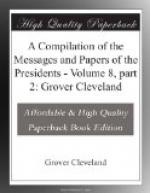Note VI.
The fact that a line drawn from the source of the Kennebec to the mouth of the Chaudiere or thereabout must be one of the boundary lines of the grant to the Duke of York has not escaped the notice of Messrs. Featherstonhaugh and Mudge; but they have not derived the true result from this discovery. The Kennebec being the western limit of the grant, the line in question bounds the territory on the southwest, while they infer that it bounds it on the northeast. In making this inference they appear to have forgotten that the St. Croix is the eastern boundary of the grant. By their argument the grant to the Duke of York is blotted wholly from the map, or, rather, becomes a mathematical line which is absurd.
Note VII.
No name which has ever been applied to any part of North America is as vague as that of Acadie. The charter to De Monts in 1604 extended from the fortieth to the forty-sixth degree of north latitude; that is to say, from Sandy Hook, at the mouth of the Hudson, to the peninsula of Nova Scotia. It therefore included New York, parts of New Jersey and Pennsylvania, and all the New England States, but excluded the disputed territory. His settlement was at the mouth of the St. Croix, but was speedily removed to Port Royal. The latter place was soon after destroyed by an expedition from Virginia under Argall. Under the title derived from this conquest it would appear probable that the celebrated grant to Sir William Stirling was made; but when his agents attempted to make settlements in the country they found that the French had preoccupied it. Although the son of Alexander succeeded in conquering the country granted to his father, and even beyond it to the Penobscot, it was restored to France by the treaty of St. Germains in 1634, and the Alexanders were indemnified for the loss by the Crown of England.




